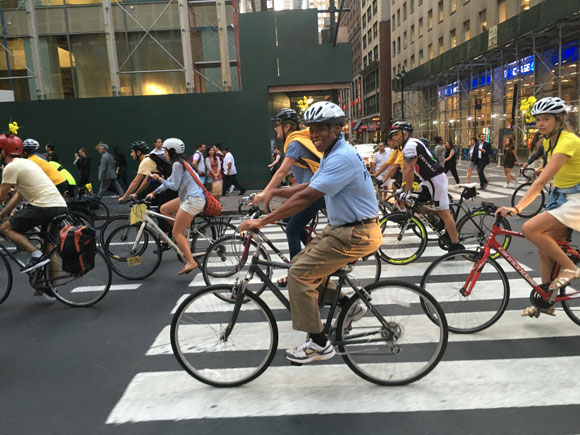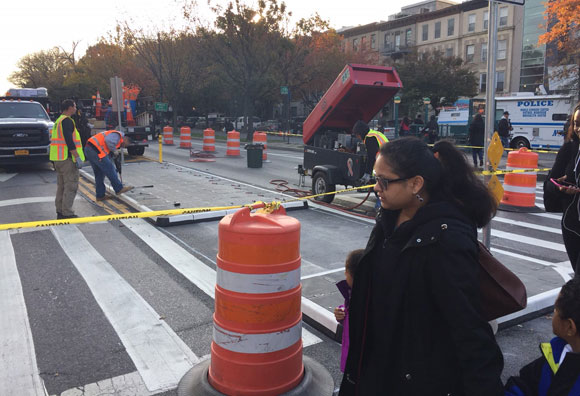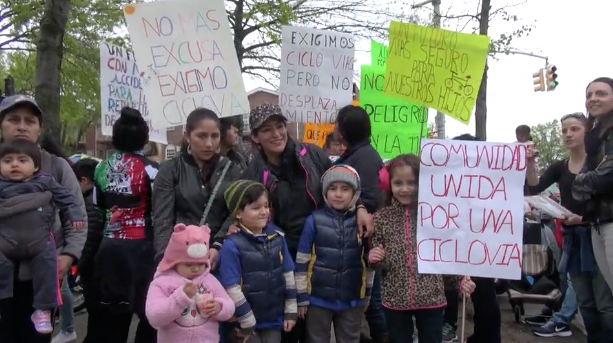In part one of the Streetsies, we looked back at the best street redesigns and policy wins of 2016. In part two, we reviewed the last 12 months of Andrew Cuomo's poor transit stewardship. If Streetsblog was Jeopardy!, the third and final round of Streetsies would be called "Potpourri."
With this post we conclude our coverage of 2016 and start looking forward to the year ahead. To produce reporting and commentary that improves walking, biking, and transit in NYC, we count on support from our readers -- you can keep us going strong in 2017 with a tax-deductible year-end contribution.
Have a wonderful New Year, Streetsblog readers. We'll be back to our regular publishing schedule on Tuesday.
Activists of the Year
Campaigning to transform 111th Street into a safe walking and biking connection to Flushing Meadows Corona Park, Mujeres en Movimiento spent 2016 marching in the streets of Corona, rallying on the steps of City Hall, and putting up with the old boys club at Queens Community Board 4. They confronted a stubborn opponent in Assembly Member Francisco Moya, and they never gave up.
With any justice, in 2017 Mayor de Blasio and DOT will reward their activism by moving ahead with the city's original safety plan for 111th Street, instead of the version the city watered down to appease Moya.
Elected Official of the Year

This was a year in which a lot of good legislative ideas bubbled up in the City Council. Ritchie Torres introduced a bill to make community boards more accountable and transparent about their membership. Carlos Menchaca got traction for his bill to legalize a common precaution cyclists take -- advancing with the pedestrian signal to avoid conflicts with turning drivers. Jumaane Williams shepherded through a bill to beef up guaranteed bicycle access to office buildings. And Public Advocate Letitia James strengthened legal protections for people in crosswalks.
For another year, Ydanis Rodriguez ran the transportation committee as a forum for discussing big issues like how to deliver better bus service. Thanks to him, the era when council members turned every transportation hearing into a gripefest about the ceaseless hassle of parking one's car is almost a distant memory.
In the runner-up slot is Antonio Reynoso, who consistently stood up for safer street designs in his district and didn't back down when the local community board voted against the Myrtle-Wyckoff plaza project.
For outstanding overall contribution, Streetsblog's elected official of the year is Brooklyn Borough President Eric Adams. Adams was everywhere in 2016, speaking out for a safer Atlantic Avenue, for better bus service, and for City Hall to "be leading the globe by making streets safer." He set the agenda in important respects. Adams' proposal for a two-way protected bike lane on Flatbush Avenue by Prospect Park could lead to a bike access breakthrough for the neighborhoods east of the park. And he publicly called out NYPD for blaming victims of traffic violence in the press before all the facts are in. Coming from a former cop, it was a message that should carry extra weight.
Biggest Opportunity
The prospect of 18 months with no L train west of Bedford Avenue is extremely alarming. New York has never had such an urgent reason to get cars out the way and turn major streets over to transit, biking, and walking.
Biggest Albany Blunder
In 2014 and 2015, traffic fatalities in New York dropped to new lows as the city installed its first automated speed enforcement cameras. The city finally had a tool to consistently enforce the speed limit on surface streets, but Albany legislation caps the number of cameras at 140 and limits where they can be placed. Not every street that needs a speed camera gets one.
This year, Transportation Alternatives and Families for Safe Streets waged an energetic campaign in the state capitol to lift those restrictions. The bill was guaranteed to save lives, but Albany's big players never made it a priority. Reluctant to do anything that might advance the de Blasio agenda, Governor Cuomo and legislative leaders failed to act on the speed camera bill.
Biggest Distraction
New York has a host of transit needs more pressing than a Brooklyn-Queens waterfront streetcar, but it's de Blasio's streetcar that will now consume time, attention, and other scarce public resources for years on end.
Biggest Rebound
The bike-share turnaround that began last year accelerated in 2016, with Citi Bike logging a 40 percent increase in annual trips. The new round of bike-share expansion thankfully included a number of "infill" stations -- ensuring that anywhere in the service area, a station is always just a short walk away. Now that bike-share is hitting ridership records all the time, the next question is, "How big will it get?"
Biggest Letdown
City Hall's much-hyped, multi-million dollar report on Uber and Manhattan traffic congestion turned out to be so threadbare, we're not any wiser about the traffic impacts of Uber than we were before it was released.
Best Executive Decision
The mayor made the right call when he overruled Queens Community Board 4 and gave the green light to phase two of the Queens Boulevard redesign.
Fishiest Decision
For some reason NYPD insisted on removing pedestrian islands from a Crown Heights intersection along Eastern Parkway to make room for the West Indian Day Parade, even though the parade is just one day a year and goes by another section of Eastern Parkway with the same type of islands. The mayor's office insisted no political motive was at work, and DOT later replaced the islands with a "removable" version, but the whole episode smelled funny.

The Foot, Meet Mouth Award
Runner-up: PBA President Pat Lynch complained that Mayor de Blasio's Vision Zero initiative "boils down to police officers enforcing traffic laws," which he finds objectionable. But two years ago Lynch was all about "hiring more police officers and assigning them to traffic enforcement." Back then, Lynch was out to stop a speed camera bill in Albany. His only consistent objective, it seems, is to undermine whatever method of traffic enforcement is currently up for debate.
First place: Before he left NYPD, Police Commissioner Bill Bratton told an auditorium full of street safety advocates at a national street safety conference that the goal of eliminating traffic deaths "will probably remain elusive."
Slowest Agency
The Department of Design and Construction operates in geologic time. Maybe your children will live to see the full build out of projects like the Brooklyn Waterfront Greenway or Select Bus Service on Woodhaven Boulevard, but DDC is in no rush to get them done in our lifetime.
Best Reason to Wrest Control of the Hudson River Greenway From the Parks Department and Hudson River Park Trust
To thousands of New Yorkers who bike on the Hudson River Greenway, it's the fastest, safest way to travel north or south on the West Side of Manhattan. To the agencies that manage the greenway, bike travel is an afterthought. Hence the Parks Department's decision to deal with summertime crowding on a narrow section of the greenway by sending cyclists on a hilly, year-round detour over the 79th Street Rotunda.
There's no rationale for the detour during off-peak months when the greenway isn't crowded, but the Parks Department's Margaret Bracken insisted on an inflexible, year-round reroute. When someone suggested treating the greenway as a transportation route, Bracken scoffed at the notion that anyone should expect to bike along the greenway without "getting off."
NIMBY of the Year
Woody Allen's genteel objections to thermoplastic stripes on the streets of the Upper East Side were amusing, but a real New York City street fight has to revolve around parking. The Carroll Gardens/Park Slope bike-share NIMBYs gave us a classic of the genre, complete with dueling online petitions, multiple sessions of public venting, and an aggressive outburst at a Brooklyn CB 6 meeting that got a write up in the Daily Mail. Only parking can stir the spleen like this:
The Six Years Too Late Award
Nearly six years after launching a PR campaign against NYC DOT's bicycle program in the form of frivolous litigation, Louise Hainline and Norman Steisel, a.k.a. Neighbors for Better Bike Lanes, finally stopped harassing the city in court. By the time they quit, the damage was already done, but at least the Prospect Park West bike lane lawsuit will be one thing you don't have to worry about in 2017.







